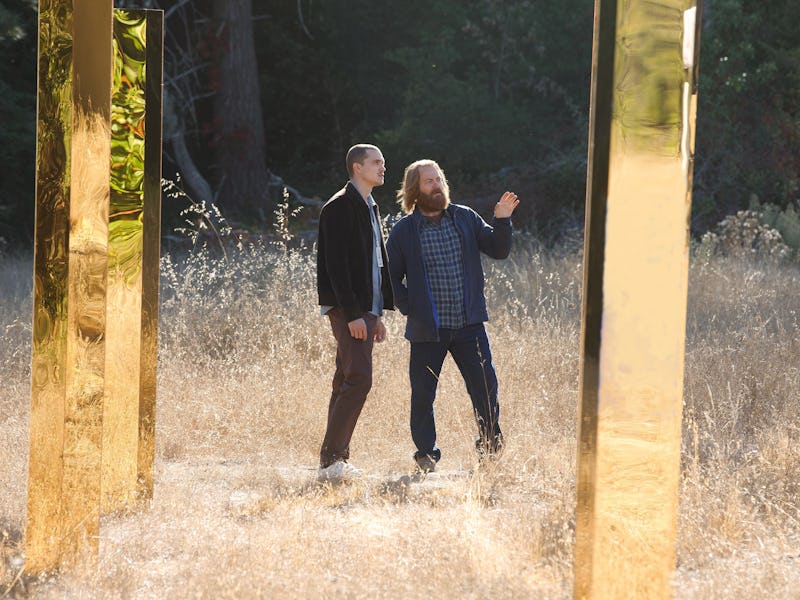Devs steals 1 idea from 2001: A Space Odyssey to launch its sci-fi epic
What if Stanley Kubrick made a TV show?

A few moments into Devs and it's plain to see the new show from Alex Garland (Ex Machina, Annihilation) is an outlier. From its opening, the audience is treated to artful, slow-moving, overhead shots of San Francisco. The cityscape is intercut with bits and pieces of a story yet to unfold: an unmoving intense visual of a deadpan Nick Offerman, a glimmering gold pillar in a field, the monolithic statue of a wide-eyed toddler looming over a vast sea of trees.
This may be the beginning sequence that introduces Garland's first foray into television, but the striking imagery, haunting soundscape, and philosophical themes help establish almost immediately that Devs is more than just another TV show. It's a Stanley Kubrick-inspired cinematic work-of-art.
On the surface, Devs is the story of a software engineer named Lily (Sonoya Mizuno) who, upon the discovery that her boyfriend Sergei (Karl Glusman) had gone missing after accepting a highly-coveted position in the aptly named "Devs" department at Amaya, the tech firm they both work for, uncovers a conspiracy connected with the company and its CEO Forest (Offerman).
But this tech murder mystery is just the narrative that drives the story forward. Beneath it is determinism, a high falutin concept that kills the notion of free will. The quantum theory posits that, within our universe, every cause leads to an eventual effect. It's the hard-to-wrap-your-head-around idea that weaves everything together in this story, from Sergei's disappearance to the mysterious algorithms Forest's team is running behind-the-scenes.
'2001: A Space Odyssey'
Connecting it all is a substantial AI presence. While it's not at all the HAL 9000 from 2001: A Space Odyssey, the use of a heightened quantum computer at the show's center begins to place the entire first episode into a disturbing Kubrickian box.
The ominous tone continues once Sergei is introduced to the Devs facility. We're led to experience the awe he feels upon first laying eyes on the structure, which looks almost like an ancient temple from Indiana Jones. Guarded by a Faraday cage made up of the gold pillars we catch a glimpse of in the beginning of the episode, a list of security measures put in place to ward off threats is listed off before Forest guides Sergei inside.
It's when they get inside, though, that the series takes on a completely different life. As much as Kubrick's work was both ahead of its time and relied heavily on practical effects, Devs creates its otherworldly secretive facility, not with computer-generated effects, but with a practically built, high tech set.
The odd, futuristic cubic Devs lab is powered exclusively by electromagnetic waves, Forest explains, allowing a floating box of glass and metal to transport visitors into a central room without ever touching the ground. At the center of that room is an odd-looking quantum computer running the mysterious code and algorithm attached to the secret project. It may look more like a steampunk sculpture wrapped in a robe of copper tubing and wires, but the set-piece was modeled after the real-life copper-covered quantum computers used by tech giants like Google.
The quantum computer at the heart of 'Devs.'
"Real-life quantum computers need very precise cooling, it turns out, which requires a lot of copper tubing in beautiful arcs," Wired reports, adding that the prop in question weighs in at roughly three-quarters of a ton.
That sort of fabrication work bled into the rest of the show's world-building as well. The giant, glimmering Devs cube, as it's introduced in the series, would probably have worked just as well as a digitally created visual, but Garland's team physically pieced that together, too.
Wired describes the set as "a 30-foot-tall Menger sponge" surrounded by gold-lined walls lined with pulsing, hypnotizing LEDs. Something tells us that visiting the set during the production was probably just as striking to the senses as the finished product is.
As heady as the series feels, it's built upon some welcome low-tech visual effects and practical sets that help bring this high-concept show down to earth. Ultimately, the sum of these abstract parts (bizarre visuals, haunting music, weird gadgets) leads to a mind-bending story that feels completely within our collective understanding and physical reach. Even if it isn't.
'2001: A Space Odyssey'
In 2001: A Space Odyssey, Kubrick gave a claustrophobic look at humanity and its profound evolution amid an expansive outer space backdrop. During the movie's climax, the past and future melded together in a flash of color, leaving the viewer inspired, curious and quite disoriented.
Through its glacially paced narrative, Devs similarly skews our perspective of human existence. It not only emphasizes the theory that life is predetermined — as Forest explains to Sergei much later in the premiere episode — it does so with a cutting edge flair that's begging to be studied in college film appreciation classes across the country.
Like David Lynch did with the medium before him — especially with 2017's Twin Peaks: The Return — or the unmistakable style of Stanley Kubrick, Alex Garland's Devs is an uncompromising, personal vision that slowly sinks the unsuspecting viewer into an audio-visual maelstrom.
In its first episode, Devs draws us in with incredible practical effects (and a whole lot more), but the experience is just beginning. And like the voyage of the Discovery One in 2001: A Space Odyssey, it’s only going to get weirder.
Devs releases new episodes on Thursdays via FX on Hulu.